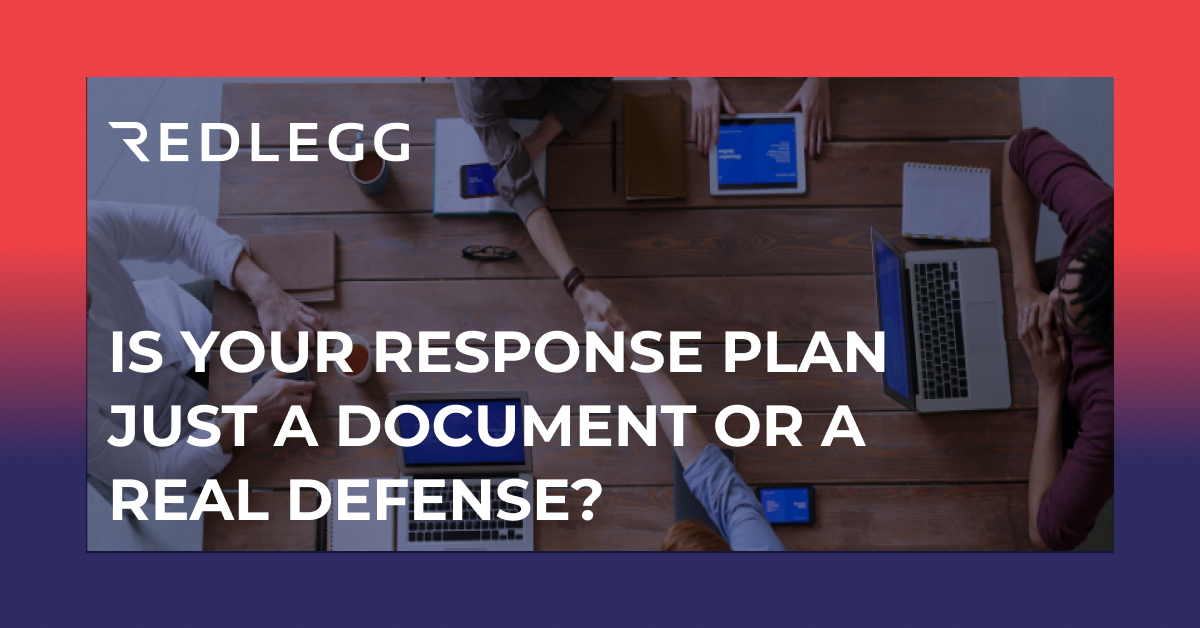13 min read
By: RedLegg Blog
What If Your Team Were Hit by Ransomware Today?
The screens are dark. File names are encrypted. Executives are demanding updates. Your inbox is full of alerts. Legal wants a meeting. The pressure is immediate, and no one is quite sure who’s leading the response.
For many companies, this is not a far-fetched scenario. It's the reality of a ransomware incident in 2025.
Most organizations have an incident response plan in place. But having a plan isn’t the same as being prepared. A real-world ransomware attack introduces urgency, confusion, and stress, none of which are easily simulated on paper.
That’s where ransomware tabletop exercises come in. Done well, they go beyond compliance and documentation. They help teams uncover gaps, align responsibilities, and practice decision-making in high-stakes conditions. In short, they turn theory into readiness.
Why Ransomware Tabletop Exercises Are a Must in 2025
Ransomware attacks have evolved into deliberate, human-led campaigns. Threat actors don’t just encrypt files randomly; they do reconnaissance, understand your systems, and go after the data and infrastructure that matter most.
Meanwhile, expectations around preparedness are rising. Cyber insurance providers, regulators, and boards are no longer satisfied with policies sitting in a drawer. They want to see that your team can respond under pressure.
A ransomware tabletop exercise helps:
- Validate your IR plan under realistic conditions
- Build trust and clarity across technical and business teams
- Expose process, communication, or tooling gaps before they matter most
- Align stakeholders around response priorities and escalation paths
And while ransomware remains a top concern, many organizations are also exploring tabletop scenarios that address insider threats, where disgruntled employees can delete, leak, or alter sensitive data. Exercises that incorporate both types of threats offer even more value, especially in sectors where data access is widespread.
If your organization hasn’t run a tabletop exercise in the last 6–12 months, you may be assuming readiness that doesn’t exist.
What a Good Tabletop Exercise Really Looks Like
A tabletop shouldn’t feel like a static checklist review.
In the past, many organizations gathered in a conference room, read through an incident scenario, and talked about what they would do. But these low-pressure, low-engagement sessions rarely uncover the issues that make a difference in an actual incident.
A well-designed tabletop exercise should be:
- Interactive, with live scenario updates (“injects”) that require real-time decisions
- Cross-functional, involving legal, HR, IT, marketing, and executive leadership
- Realistic, simulating the kind of pressure and ambiguity that arise in real incidents
Effective exercises include:
- Conflicting or incomplete information
- Time-sensitive decisions with business consequences
- Escalation moments (e.g., briefing the board, responding to media)
- Technical ambiguity that forces collaboration between roles
The goal is not to “win” the scenario. It’s to learn where the plan breaks down—and where your team can improve.
Designing a Tabletop That Actually Moves the Needle
A successful tabletop exercise isn’t about volume, it’s about focus. One powerful, well-structured scenario will drive far more value than trying to cover every threat at once.
To get the most out of your exercise:
- Based on relevant threats: Use recent ransomware tactics or threat intelligence specific to your sector.
- Bring the right people to the table: Include not just the technical team but also legal, communications, risk management, and business leadership.
- Create urgency: Set time limits for decisions. Introduce uncertainty and conflicting priorities.
- Define outcomes: Track how long it takes to detect, respond, escalate, and communicate. These metrics can shape future training and investment.
One highly effective addition to any ransomware tabletop is to focus on your “crown jewels”, the systems or data your business can’t afford to lose.
Every organization has them. It could be a manufacturing control system, your customer database, financial reporting software, or proprietary designs. During the scenario, ask your team:
“What happens if this system becomes encrypted, deleted, or unavailable?”
“Can we continue to operate? Is there a workaround? Who decides the next step?”
In many cases, the answers reveal operational gaps, not just in cybersecurity but in business continuity. While teams may have strong protections in place, they often lack a defined plan for how to function without that system. By incorporating this line of questioning, tabletop exercises become more than a test of response—they become a tool for strategic risk reduction.
From Exercise to Evolution: What Happens Next
Running the exercise is only part of the value. The real gains come from what happens afterward.
After the scenario:
- Debrief with all participants: Capture immediate feedback while it’s fresh.
- Document findings: Identify areas where the response went well and where it lagged.
- Update your plans: Incident response, business continuity, and communication protocols should all evolve.
- Assign follow-ups: Gaps uncovered during the exercise should have clear owners and deadlines.
Organizations that mature their tabletop programs over time often see direct benefits during real incidents. Teams communicate faster, escalation paths are clearer, and decisions are more aligned with business priorities. In critical moments, those advantages can mean the difference between recovery and catastrophe.
Better to Sweat in the Tabletop Than Bleed in Production
In cybersecurity, stress is inevitable, but surprise is optional.
Ransomware tabletop exercises offer an opportunity to test your plans, your people, and your assumptions in a safe environment. They surface the uncomfortable truths before they become public crises.
A well-executed tabletop can uncover the blind spots that put your operations at risk, and give your team the clarity, confidence, and coordination they need to act when it counts.
Looking for a Starting Point?
Get inspired by real-world scenarios. Download our free ransomware tabletop sample scenarios to see how organizations are preparing for today’s most common threats.
Want more? Read about...






